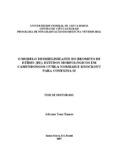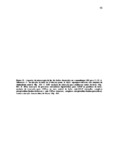| dc.creator | Ramos, Adriano Tony | |
| dc.date.accessioned | 2017-05-29 | |
| dc.date.available | 2017-05-29 | |
| dc.date.issued | 2007-12-14 | |
| dc.identifier.citation | RAMOS, Adriano Tony. Ethidium bromide (eb) demyelinating model: morphologic studies in C57BL/6 normal and CX 32 knockout mice. 2007. 174 f. Tese (Doutorado em Medicina Veterinária) - Universidade Federal de Santa Maria, Santa Maria, 2007. | por |
| dc.identifier.uri | http://repositorio.ufsm.br/handle/1/4030 | |
| dc.description.abstract | Light and ultraestructural changes of central and peripheral nervous system lesions in mice KO for connexin-32
and submitted to the ethidium bromide gliotoxic demyelinating model are described. Their KO condition was tested with PCR and a negative connexin-32 labelling was performed by immunofluorescence. The experimental animals were C57BL/6 normal mice and C57BL/6 KO for connexin-32. For all groups the animals were maintained in cages of 5 individuals within a temperature controlled room and had ration and filtered water ad libitum. A single local injection of either 0,1% ethidium bromide in normal saline (5 μl in the brainstem and 1 μl in the sciatic nerve) or normal saline was performed as described for Wistar rats. The injected mice were observed daily until euthanasia was performed at 24, 48 hours and 3, 7, 15, 21 and 30 days after injection. The mice were perfused through the heart with either neutral 10% formalin or 2,5% glutaraldehyde. Histochemical, immunohistochemical, immunofluorescence and transmission electron microscopic methods were used to analyze the development of the lesions after differentiated processing. Hematoxylin- eosine, luxol fast blue and toluidine blue methods and immunolabelling with anti-GFAP, anti-CNPase, anti-S100 protein and anti-OSP,
anti Cx32 and anti Cx43 antibodies were used. Within the CNS the lesions showed an acute degenerative phase
with disappearance of glial cells, and myelin sheaths were withdrawn by a scant number of macrophages. In KO
mice some granulocytes were detected within the lesions in tight contact with decaying myelin sheaths. Remyelination was carried out by oligodendrocytes since no Schwann cells were seen during the regenerating process of KO mice. Occasional remyelinating Scwann cells were seen in normal mice. For the sciatic nerves, Schwann cells initially showed signs of intoxication and rejected their sheaths; after seven days, some thin newly formed myelin sheaths with uneven compaction and redundant loops (tomacula) were conspicuous. Mast cells degranulated or not were seen in all BE- induced lesions and after saline injection. It is concluded that the repair of the CNS demyelinated lesions differs from the observed in normal and immunosupressed rats because Schwann cells remyelination was absent; the absence of connexin-32 may have caused that absence. The
regeneration of lost myelin sheaths within the PNS followed the pattern already reported for this model in other species. It is suggested that the absence of connexin-32 determined the different repair of the myelin sheaths within the CNS whereas for the PNS, the normal pattern of tissue response might be due to the early age of the injected mice. | eng |
| dc.description.sponsorship | Coordenação de Aperfeiçoamento de Pessoal de Nível Superior | |
| dc.format | application/pdf | por |
| dc.language | por | por |
| dc.publisher | Universidade Federal de Santa Maria | por |
| dc.rights | Acesso Aberto | por |
| dc.subject | Brometo de etídio | por |
| dc.subject | Desmielinização | por |
| dc.subject | Remielinização | por |
| dc.subject | Conexina32 | por |
| dc.subject | Knockout | por |
| dc.subject | Histoquímica | por |
| dc.subject | Imunoistoquímica | por |
| dc.subject | Neuropatologia experimental | por |
| dc.subject | Ethidium bromide | eng |
| dc.subject | Demyelination | eng |
| dc.subject | Remyelination | eng |
| dc.subject | Connexin 32 | eng |
| dc.subject | Knockout | eng |
| dc.subject | Histochemistry | eng |
| dc.subject | Imunohistochemistry | eng |
| dc.subject | Experimental neuropathology | eng |
| dc.title | O modelo desmielinizante do brometo de etídio (be): estudos morfológicos em camundongos C57BL/6 normais e knockout para conexina 32 | por |
| dc.title.alternative | Ethidium bromide (eb) demyelinating model: morphologic studies in C57BL/6 normal and CX 32 knockout mice | eng |
| dc.type | Tese | por |
| dc.description.resumo | São descritas as alterações de microscopia de luz e ultra-estruturais induzidas pelo brometo de etídio no sistema
nervoso central e periférico de camundongos KO para conexina 32. O genótipo KO foi testado por PCR e
confirmado por imunofluorescência negativa para conexina 32. Os animais dos experimentos foram camundongos C57BL-6 normais (controles) e KO para conexina 32. Todos os camundongos foram mantidos em gaiolas de 5 indivíduos em sala climatizada e receberam ração e água à vontade. Uma única injeção de BE 0,1% em salina 0,9% ou de salina 0,9% (5 μl na cisterna basal e 1μl no nervo ciático) foi realizada como descrita em ratos Wistar. Os camundongos eram observados diariamente até ser realizada a eutanásia às 24 e 48 h, 3, 7, 15, 21 e 30 dias após a injeção. Os camundongos foram perfundidos através do coração; um grupo com glutaraldeído 2,5% visando o processamento para microscopia eletrônica; um outro grupo com solução salina
com EDTA e posterior fixação em metacarn para inclusão em parafina. As amostras incluídas em parafina foram
analisadas através dos métodos de hematoxilina e eosina, luxol fast blue e azul de toluidina. Foram realizadas
imunoistoquímica e imunofluorescência visando a marcação de GFAP, CNPase, OSP, S100, e Cx43 e Cx32,
respectivamente. As lesões do SNC eram discretas e tiveram uma fase ativa com desaparecimento das células
gliais; os debris celulares e de mielina foram retirados por um reduzido número de fagócitos. Nos camundongos
KO foram vistos granulócitos em estreito contato com bainhas de mielina em degradação. A remielinização dos
axônios desmielinizados foi realizada exclusivamente por oligodendrócitos nos camundongos KO; nos
camundongos normais, ocasionais células de Schwann podiam ser encontradas remielinizando axônios do SNC.
No nervo ciático, as células de Schwann intoxicadas rejeitaram seus internodos de mielina; após sete dias, finas
bainhas reparadas eram encontradas, com compactação irregular da mielina e alças redundantes (tomacula).
Mastócitos, desgranulados ou não, eram vistos nas lesões do BE e após a injeção de solução salina. Conclui-se
que o reparo das lesões do SNC difere do observado em ratos normais e imunossuprimidos devido à ausência de
remielinização por células de Schwann; a falta de expressão da Cx 32 e o tamanho reduzido das lesões podem ter
contribuído para essa ausência. A regeneração das bainhas perdidas no SNP obedeceu ao padrão descrito para
esse modelo em outras espécies. Sugere-se que a ausência da Cx 32 não afetou o reparo do SNP devido à idade
precoce dos animais. | por |
| dc.contributor.advisor1 | Graça, Dominguita Luhers | |
| dc.contributor.advisor1Lattes | http://buscatextual.cnpq.br/buscatextual/visualizacv.do?id=K4783904A3 | por |
| dc.contributor.referee1 | Fernandes, Cristina Gevehr | |
| dc.contributor.referee1Lattes | http://buscatextual.cnpq.br/buscatextual/visualizacv.do?id=K4723887P9 | por |
| dc.contributor.referee2 | Schetinger, Maria Rosa Chitolina | |
| dc.contributor.referee3 | Morsch, Vera Maria | |
| dc.contributor.referee3Lattes | http://buscatextual.cnpq.br/buscatextual/visualizacv.do?id=K4784273E6 | por |
| dc.creator.Lattes | http://buscatextual.cnpq.br/buscatextual/visualizacv.do?id=K4730835A4 | por |
| dc.publisher.country | BR | por |
| dc.publisher.department | Medicina Veterinária | por |
| dc.publisher.initials | UFSM | por |
| dc.publisher.program | Programa de Pós-Graduação em Medicina Veterinária | por |
| dc.subject.cnpq | CNPQ::CIENCIAS AGRARIAS::MEDICINA VETERINARIA | por |




